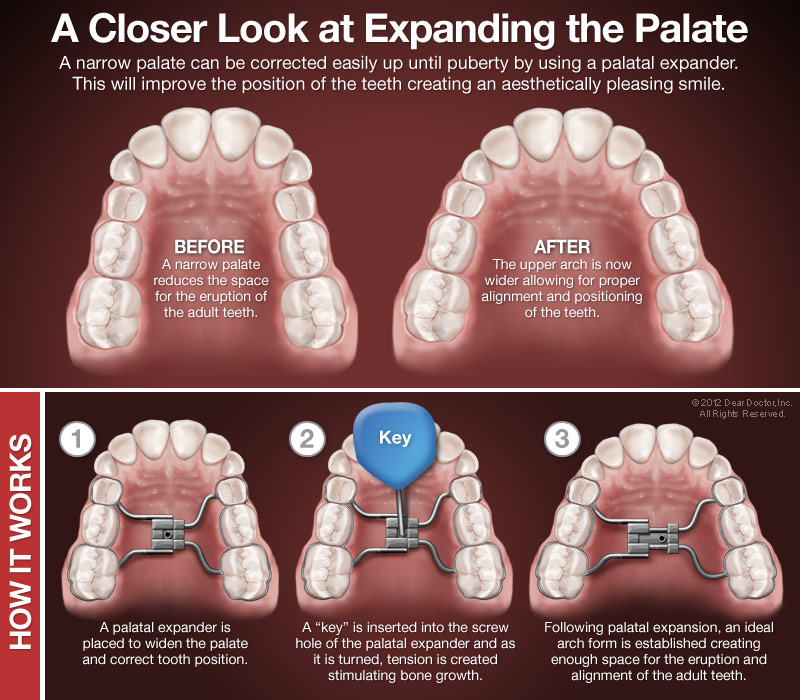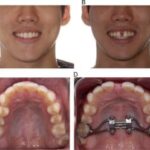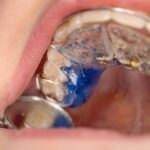If you or your child has been recommended a palate expander, you may be wondering what it is and how it works. A palate expander is a dental device that is used to widen the upper jaw. It is commonly used in orthodontic treatment to correct issues such as crowding, crossbite, or a narrow palate.
The palate expander key plays a crucial role in the effectiveness of the device. It is a small tool that is used to activate the expander and adjust its width. The key is inserted into the expander and turned in a specific direction to gradually widen the device. This process puts gentle pressure on the upper jaw, encouraging it to expand over time.
Some patients may experience mild discomfort or pressure when the expander is first activated or adjusted. This is normal and should subside within a few days. Your orthodontist will monitor your progress and make any necessary adjustments to ensure the expander is working effectively.
A palate expander is a dental device that is used to widen the upper jaw in order to create more space for teeth to properly align. It is commonly used in orthodontic treatment for children and teenagers who have narrow jaws or crowded teeth.
Palate expanders work by applying gentle pressure on the upper jaw, gradually widening it over a period of time. This expansion allows the upper jaw to match the width of the lower jaw, improving the overall bite and alignment of the teeth.
The device consists of a metal framework that is custom-made to fit the patient’s mouth. It is typically attached to the molars using bands or cemented to the roof of the mouth. The palate expander also includes a key, which is used to activate the device and adjust the expansion. The key is inserted into a small opening in the expander and turned to widen the device.
During the initial consultation, the orthodontist will determine if a palate expander is necessary and appropriate for the patient. They will take impressions and X-rays of the patient’s mouth to create a personalized treatment plan. The expander will be fitted and adjusted by the orthodontist, and the patient will be instructed on how to use the key to activate the device.
Overall, palate expanders are an effective and non-invasive treatment option for correcting narrow jaws and crowded teeth. They can help improve the bite, create space for teeth to properly align, and enhance overall oral health. If you or your child has orthodontic concerns, consult with an orthodontist to determine if a palate expander is the right treatment option.
Benefits of Using a Palate Expander Key
A palate expander key is a valuable tool in orthodontic treatment that offers several benefits for patients. Here are some of the key advantages of using a palate expander key:
1. Corrects Crossbite:
A palate expander key is specifically designed to correct crossbite, which occurs when the upper teeth bite inside the lower teeth. By widening the upper jaw, the expander key helps align the upper and lower teeth properly, improving the bite and overall dental health.
2. Expands the Palate:
3. Enhances Breathing and Speech:
A narrow palate can sometimes lead to breathing difficulties and speech problems. By widening the palate, a palate expander key can help improve airflow through the nasal passages, making it easier to breathe. It can also enhance speech clarity by creating more room for the tongue to move properly.
4. Prevents or Reduces the Need for Extractions:
In some cases, a palate expander key can prevent or reduce the need for tooth extractions. By creating more space in the mouth, it allows the teeth to align naturally, eliminating the need for removing healthy teeth to make room for crowded ones.
5. Facilitates Orthodontic Treatment:
A palate expander key is often used as a preliminary step in orthodontic treatment. By expanding the palate and creating more space, it helps facilitate the movement of teeth during braces or other orthodontic procedures. This can lead to more efficient and effective treatment outcomes.
How Palate Expanders Work
A palate expander is a dental device that is used to widen the upper jaw in order to create more space for the teeth. It is commonly used in orthodontic treatment to correct issues such as crowding, crossbite, and narrow arches.
Palate expanders work by applying gentle pressure on the upper jaw, gradually widening it over a period of time. The device consists of two halves that are connected in the middle by a screw. By turning the screw with a palate expander key, the two halves of the device are pushed apart, creating tension on the jaw and causing it to expand.
The Process of Palate Expansion
When a palate expander is first placed in the mouth, it may feel uncomfortable or tight. However, over time, the jaw will adjust to the pressure and the device will become more comfortable to wear.
The expansion process typically takes several months to complete. During this time, the patient will need to visit the orthodontist regularly to have the expander adjusted. At each visit, the orthodontist will use the palate expander key to turn the screw, gradually widening the device and the jaw.
Benefits of Palate Expanders
Palate expanders offer several benefits for individuals undergoing orthodontic treatment:
- Correcting dental issues: Palate expanders can help to correct a variety of dental issues, including crowding, crossbite, and narrow arches.
- Creating space: By widening the upper jaw, palate expanders create more space for the teeth to move into their proper positions.
- Improving facial appearance: Palate expanders can help to create a more symmetrical and balanced facial appearance by correcting jaw alignment issues.
- Enhancing breathing and speech: By expanding the upper jaw, palate expanders can improve breathing and speech function in individuals with narrow airways or speech difficulties.
Overall, palate expanders are an effective and non-invasive treatment option for correcting dental issues and improving overall oral health. They can help to create a beautiful smile and a healthy bite.
Types of Palate Expanders
Palate expanders are orthodontic devices used to widen the upper jaw and create more space for crowded teeth. There are several types of palate expanders that orthodontists may use, depending on the individual needs of the patient. These include:
1. Rapid Palatal Expander (RPE)
The Rapid Palatal Expander is a commonly used type of palate expander. It consists of a metal framework that is attached to the upper molars with bands or rings. The expander has a screw in the middle that can be turned using a key. This allows the orthodontist to gradually widen the palate over a period of time.
2. Haas Expander
The Haas Expander is another popular type of palate expander. It is similar to the RPE, but it has a different design. The Haas Expander also has a screw in the middle that can be turned with a key, but it is more stable and comfortable for the patient. It is often used for patients with a narrow upper jaw.
3. Quad Helix Expander
The Quad Helix Expander is a fixed palate expander that is cemented to the molars. It consists of four helical springs that apply gentle pressure to widen the palate. This type of expander is often used for patients with a narrow arch or crossbite.
4. Removable Palate Expander
The Palate Expander Key: Importance and Usage
Importance of the Palate Expander Key
The palate expander key is an integral part of the treatment plan for individuals with a narrow upper jaw or a crossbite. It allows for gradual expansion of the palate, creating more space for proper alignment of the teeth and improving overall facial symmetry.
By using the palate expander key as instructed by the orthodontist, patients can achieve optimal results in a relatively short period of time. The key allows for controlled activation of the palate expander, ensuring that the expansion process is gradual and comfortable.
Proper Usage of the Palate Expander Key
Using the palate expander key correctly is crucial for the success of the treatment. Patients should follow the instructions provided by their orthodontist to ensure proper usage.
Potential Side Effects of Using a Palate Expander
2. Speech difficulties: Some patients may experience temporary speech difficulties when wearing a palate expander. This is because the appliance can interfere with the normal movement of the tongue and palate, making it difficult to pronounce certain sounds. With time and practice, most patients are able to adapt and speak normally with the expander in place.
| Side Effect | Description |
|---|---|
| Discomfort | Common soreness in the mouth and jaw after placement |
| Speech difficulties | Temporary difficulties in pronouncing certain sounds |
| Increased saliva production | Temporary excessive saliva production |
| Difficulty eating | Challenges in eating certain foods |
| Oral hygiene challenges | Increased risk of plaque buildup and tooth decay |
| Allergic reactions | Rare cases of allergic reactions to the materials used |
Overall, the potential side effects of using a palate expander are usually temporary and manageable. With proper care and communication with your orthodontist, any discomfort or challenges can be minimized, and the benefits of the treatment can be maximized.
Tips for Caring for Your Palate Expander
https://upload.wikimedia.org/wikipedia/commons/c/ca/1×1.png
Proper care and maintenance of your palate expander are essential to ensure its effectiveness and longevity. Here are some tips to help you take care of your palate expander:
1. Maintain Good Oral Hygiene

It is crucial to maintain good oral hygiene while wearing a palate expander. Brush your teeth thoroughly at least twice a day, paying special attention to the areas around the expander. Use a soft-bristled toothbrush and fluoride toothpaste to remove any food particles or plaque that may accumulate.
2. Clean Your Palate Expander
Regularly clean your palate expander to prevent the buildup of bacteria and plaque. Use a small, soft-bristled toothbrush or a specialized orthodontic brush to clean the expander. Gently brush all the surfaces, including the wires and bands, using a mild soap or non-alcoholic mouthwash. Rinse thoroughly with water to remove any residue.
3. Avoid Sticky and Hard Foods
Avoid consuming sticky and hard foods that can damage your palate expander. These include chewing gum, hard candies, nuts, and popcorn. Stick to soft and easily chewable foods during the treatment period to prevent any damage to the expander.
4. Be Gentle with Your Palate Expander
Avoid any activities that may cause damage to your palate expander. Be cautious while eating, speaking, or participating in physical activities. If you play sports, consider wearing a mouthguard to protect your expander from any potential impact.
5. Attend Regular Orthodontic Appointments
Regularly visit your orthodontist for check-ups and adjustments. They will monitor the progress of your treatment and make any necessary adjustments to the palate expander. Follow their instructions carefully and attend all scheduled appointments to ensure the success of your treatment.
6. Report Any Issues to Your Orthodontist
If you experience any discomfort, pain, or notice any damage to your palate expander, contact your orthodontist immediately. They will be able to assess the situation and provide the necessary guidance or repairs.
By following these tips, you can ensure proper care and maintenance of your palate expander, leading to a successful orthodontic treatment and a healthier smile in the long run.

Dr. Fidel Cann: Esteemed orthodontist with a lifelong dedication to enhancing smiles and oral health. Pioneering expertise, compassionate care.





